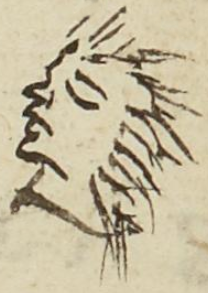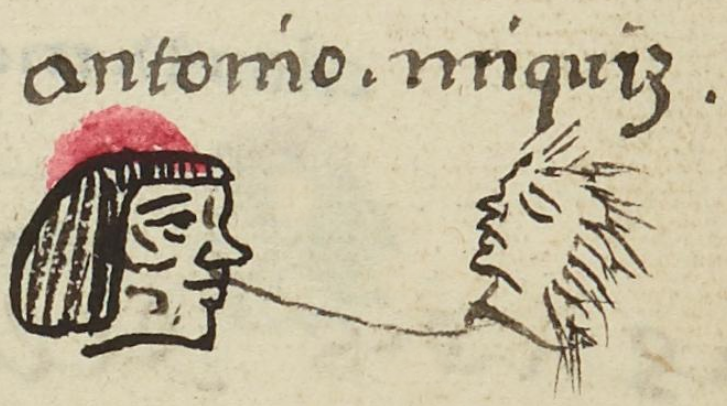Miquiz (MH677v)
This black-line drawing of the simplex glyph for the personal name Miquiz (“Death”) is attested here as a man’s name. The glyph shows the head of a man in profile, facing toward the viewer’s left. His eyes are closed, and his hair is wispy and standing out. He is deceased, a semantic indicator for the concept of death (miquiztli). The name Death is a day name in the 260-day divinatory calendar called the tonalpohualli. Calendrics were an important part of Nahuas' religious views of the cosmos.
Stephanie Wood
A day sign like Miquiz would normally have a companion number from 1 to 13 with it. Because of colonial edicts to stop using the tonalpohualli as a source for names, one thing that happened is that the companion numbers were dropped, perhaps as a stopgap measure to reduce the sacred nature of the name.
Hieroglyphs for death in this manuscript more typically show a skull (below). One other glyph, for example, shows a shrouded corpse. The latter is more typical in the Codex Mendoza in its hieroglyphs for “corpse” or “the deceased” (micqui). Another option for micqui in that manuscript is the use of a nude body laid out.
Stephanie Wood
1560
Jeff Haskett-Wood
muerte, muerto, nombres de hombres

miquiz(tli), death, https://nahuatl.wired-humanities.org/content/miquiztli
La Muerte
Stephanie Wood
Matrícula de Huexotzinco, folio 677v, World Digital Library, https://www.loc.gov/resource/gdcwdl.wdl_15282/?sp=435&st=image.
This manuscript is hosted by the Library of Congress and the World Digital Library; used here with the Creative Commons, “Attribution-NonCommercial-ShareAlike 3.0 License” (CC-BY-NC-SAq 3.0).










